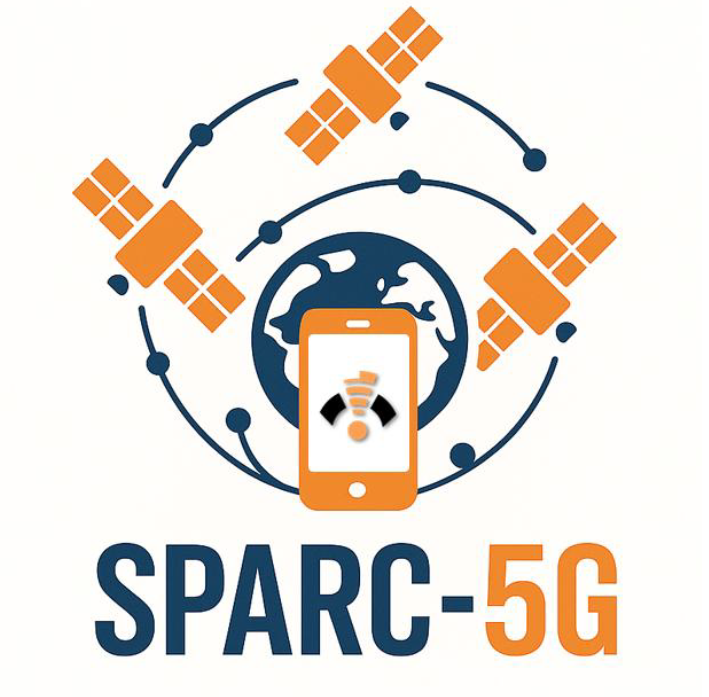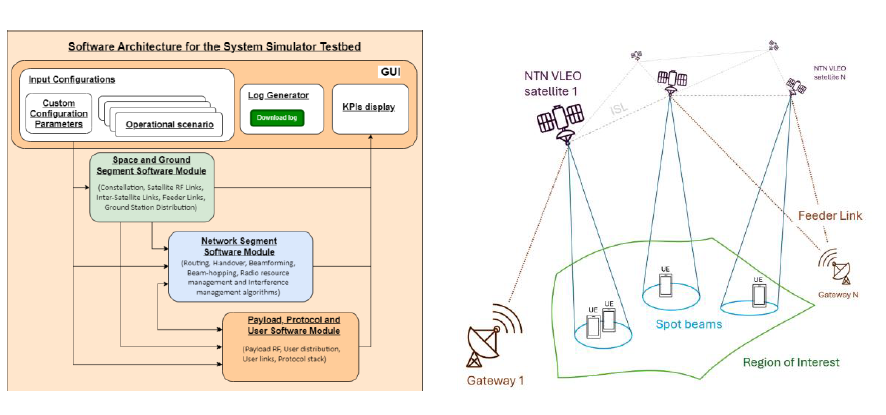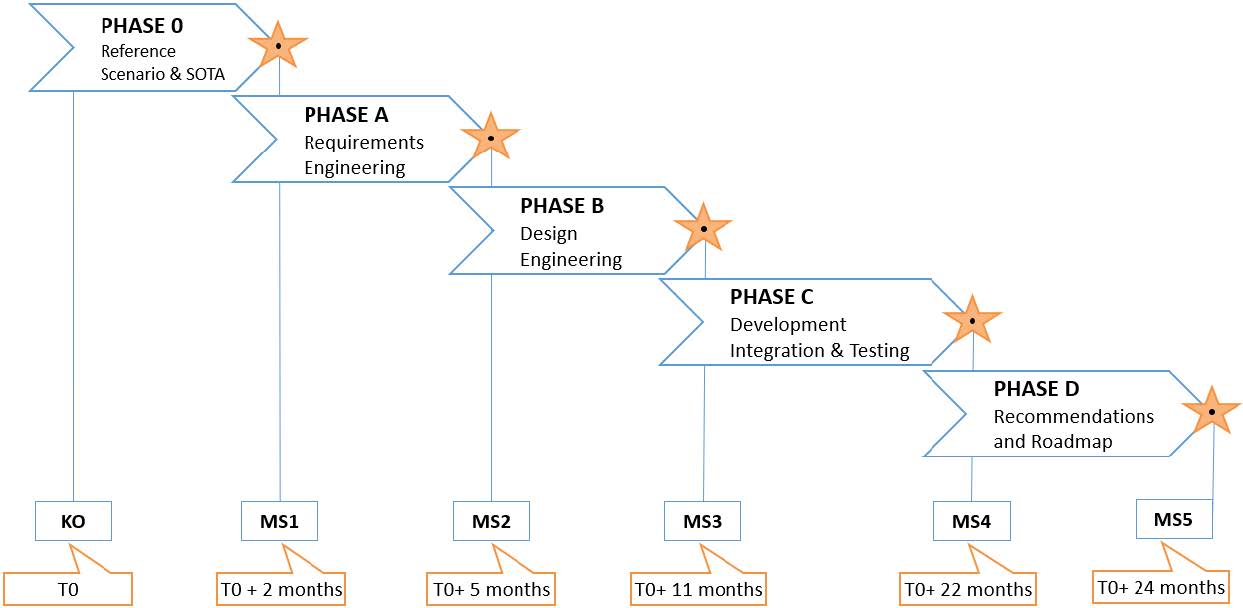
-
StatusOngoing
-
Status date2025-10-17
-
Activity Code3F.019
- Feasibility Assessment: Evaluated the feasibility of various technologies such as advanced satellite constellations, beam-hopping, and scalable network management, and provided insights into future satellite communication system design and deployment;
- Use Case Definition: Defined and modelled specific use case in the simulator. It allows for scenario customisation to evaluate different performance parameters;
- Development of a Software Simulator: Developed a modular and configurable simulator capable of modelling Very Low Earth Orbit (VLEO) satellite constellations. It includes simulating constellation behaviour, feeder links, inter-satellite links, payload RF elements, user densities, and advanced network techniques (beamforming, handovers, RRM, etc);
- Performance Optimisation: Simulator focuses on optimizing key performance metrics such as latency, throughput, and resource allocation for 5G New Radio and Narrowband Internet of Things (NB-IoT) waveforms. It is compliant with 3GPP Release 17 and 18 standards for 5G Non-Terrestrial Network (NTN) systems;
- Validate the system simulator in the lab to reach Technology Readiness Level (TRL) 5.
- Doppler shifts and frequent handovers pose significant challenges due to high relative motion between the satellites and ground stations;
- Atmospheric drag and station-keeping: Operating below a 400-kilometre altitude exposes satellites to higher residual atmospheric density, causing continuous drag and orbit decay;
- Scalable resource management and interference mitigation: Large VLEO constellations (hundreds to thousands of satellites) necessitate sophisticated Radio Resource Management (RRM), beamforming/beam-hopping, and routing strategies to maximise spectral efficiency while controlling both intra-constellation and co-frequency interference;
- High-computational requirements: Simulating hundreds of fast-moving satellites, user terminals, and inter-satellite links in real time demands scalable parallel algorithms and high-computational power.
The SPARC-5G project responded to the need of testing real-world solutions and protocols on large satellite constellations by providing a modular and comprehensive simulation environment, which:
- Encompasses all components of the NTN ecosystem: the space and network segments, ground gateways, user equipment, and inter-satellite links, providing detailed insights into the interaction between user devices, satellites, and terrestrial systems;
- Enables the simulation and optimisation of VLEO satellite NTN, ensuring seamless integration with terrestrial 5G networks, offering complicated capabilities for radio resource management, routing, beamforming, handover strategies as per 3GPP Release 17 and Release 18 standards for both 5G NR and NB-IoT waveforms;
- Allows researchers and engineers to explore new designs, address technical challenges and evaluate innovative solutions;
- Enables system-level assessment of performance under realistic conditions (throughput, latency, availability, spectral efficiency);
- Supports multiple operational scenarios, including IoT remote monitoring, broadband in underserved areas, emergency communications, and urban traffic offloading;
- Provides a TRL-5 validated software tool for VLEO NTN design and evaluation.
The developed simulation platform features:
- Accurate modelling of the VLEO satellite constellations of hundreds of satellites and assessment of their system components performance, including platform and payload radio frequency (RF) elements;
- Compliance with 5G waveforms, such as spectrum flexibility, ultra-lean design, forward compatibility, and low latency support;
- Evaluation of the system ability to meet the stringent latency, throughput, and reliability requirements of 5G NTN applications;
- Configurable scenarios: selectable regions, traffic demand, user distribution, and service type;
- Three modular software blocks:
- Space & Ground Segment module (constellation, feeder links, ISLs, gateways);
- Network Segment module (routing, RRM, handover, beamforming/beam-hopping);
- Payload, Protocol & User module (RF payload, 5G NR/NB-IoT stacks, user profiles).
- Evaluation of Key Performance Indicators (KPIs): latency, throughput, service availability, spectral efficiency, energy efficiency;
- Advanced modelling capabilities: interference management, dynamic resource allocation, routing resilience, Doppler and handover handling;
- User-friendly graphical user interface (GUI) for scenario setup, real-time monitoring of KPIs, and log-based post-simulation analysis;
- Extensible and modular design, enabling future upgrades (e.g. Release-19 features, new payload models).
The SPARC-5G simulator adopts a modular system architecture that mirrors the main elements of a VLEO satellite communication network. It integrates three software modules, each representing a core segment of the system:
- Space and ground segment module: Models VLEO constellations, orbits, platform subsystems, payload RF elements, feeder links, inter-satellite links, and ground station distribution. It supports analyses such as collision prediction, propulsion needs, station-keeping, and deorbit;
- Network segment module: Implements radio resource management (RRM), routing, beamforming, beam-hopping, traffic and load management, and handover strategies. It allows assessment of interference handling and routing resilience under varying user and satellite dynamics;
- Payload, protocol, and user module: Simulates payload control, 5G NR and NB-IoT protocol stacks (3GPP Rel-17/18), user types (mobile, stationary, IoT, eMBB), traffic profiles, and demand distributions.

The software architecture features a GUI to configure scenarios, monitor KPIs (latency, throughput, availability, efficiency) in real time, and conduct post-simulation analysis through log files.
The project is implemented in the following phases:
- Phase 0: Finalisation of the reference scenario and state-of-the-art key technology aspects related to payload, protocol stacks, radio resource management, VLEO platforms and subsystems;
- Phase A: Requirements engineering and specifications of the space, ground, network, and user segments;
- Phase B: Design engineering and implementation plans for the testbed software and different modelling solutions for all system segments;
- Phase C: Development, integration and verification of the software testbed and its testing against verification scenarios to validate user requirements and evaluate various KPIs;
- Phase D: Demonstration and recommendations.

Currently the project is in the Phase 0, the reference scenarios are being investigated, and state-of-the-art analysis is in progress.





